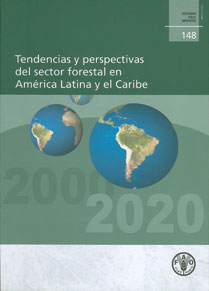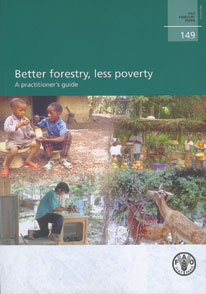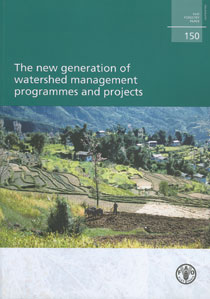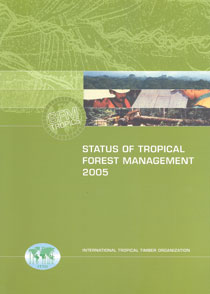 |
Tendencias y perspectivas del sector forestal en América Latina y el Caribe. 2006. FAO Forestry Paper 148. Rome, FAO. ISBN 92-5-305498-0.
For many years FAO, in collaboration with member countries, the private sector and international, governmental and non-governmental organizations, has carried out a series of forestry sector outlook studies in different regions of the world. These studies aim to identify the possible influences that can affect the future of forestry and options that may assist countries in reaching their objectives in the sector.
This publication, the final regional report of the Latin American Forestry Sector Outlook Study, builds on the national and subregional reports of 20 countries and three subregions. It describes and analyses the main trends in the region in recent years, covering such areas as forest resources, industry, products and services as well as international trade agreements, tenure issues, social and institutional capacity and law compliance. Then it analyses the main driving forces for change in the sector, such as evolving policies and institutions; demographic, technological, economic and environmental changes; and domestic and international markets. The study also considers the policies and strategies of other key sectors that can influence the forest sector.
The last section projects the likely situation of the forest sector in 2020. With regard to the extent of forests, it projects a decline in forest area from 924 million hectares in 2005 to 881 million hectares in 2020 (with 80 percent of the deforestation expected to take place in Brazil, Mexico, Peru and Venezuela). Planted forests, primarily of Pinus spp., Eucalyptus spp. and Araucaria angustifolia, are expected to increase substantially, especially in Brazil and Chile, to satisfy the growing industrial demand, particularly for pulp and paper. The area of planted forests is likely to grow from 13.1 million hectares in 2005 to 17.3 million hectares in 2020. Accordingly, sustainable wood production from planted forests is expected to increase from 303 million to 480 million cubic metres. The report examines the implications of these changes, and the role that policies play in forest area change. It examines the prospects for management of natural forests and for sustainable production from planted forests.
Despite the negative forecast for the extent of natural forests, a number of opportunities are identified for the sector. These include carbon markets, the destination of increasing forest areas for ecotourism and conservation, greater development of the non-wood forest product economy, greater opportunities for forest products from certified forests, and integration of forests with other land uses, for example in silvopastoral and agroforestry systems.
The annexes provide statistics on subjects such as forest resources, protected areas, institutions and public administration, and direction of trade.
This book provides food for thought for all who are concerned with the future of forests and forestry in Latin America and the Caribbean. Taken together, the regional, national and subregional reports represent an important reference and source of information for strategic planning at all three levels, and will be of particular relevance to national forest programmes. The reports are all available at: www.fao.org/forestry/site/2404/en
 |
Better forestry, less poverty: a practitioner’s guide 2006. FAO Forestry Paper 149. Rome, FAO. ISBN 92-5-105550-5.
More than 25 percent of the world’s population – an estimated 1.6 billion people – rely on forest resources for their livelihoods, and of these almost 1.2 billion live in extreme poverty, lacking the basic necessities to maintain a decent standard of living: sufficient and nutritious food, adequate shelter, access to health services, energy sources, safe drinking-water, education and a healthy environment. When governments signed the Millennium Declaration in 2000, they agreed to halve the number of people living in extreme poverty by 2015.
A significant number of people living in poverty depend on forests and trees outside forests for food, shelter, clothing and heating, as well as to generate income through employment and through the sale of goods and services. However, the extent to which forests can alleviate poverty and improve food security for vulnerable populations is not well documented.
Policy-makers need to be made more aware of the role of forests in poverty alleviation. However, action is not only the responsibility of governments. Foresters and others working with communities can assist poor people to increase their benefits from forest resources by helping them to access markets, acquire processing skills, obtain improved varieties of trees, combine trees and crops on their land, and form associations to manage resources jointly, strengthen negotiation power and market products.
Better forestry, less poverty aims to increase awareness so that forestry and development practitioners can make poverty reduction a focus of their work. It suggests ways to design and implement forest-based interventions that have the greatest potential to reduce poverty. The guide examines the ways in which changes in forest management can cause poverty or worsen it, and how forestry practices can better contribute to poverty reduction and better protect the livelihood functions of forests. The guide outlines key issues related to timber production in both natural and planted forests, non-wood forest products, woodfuel, bushmeat, agroforestry and payment for environmental services, summarizing successful case studies for each and identifying sources of additional information.
The guide emphasizes helping forestry practitioners gain a better understanding of the forms of rural poverty and of how decisions made at the local level affect segments of poor rural communities in different ways – women, children and the elderly being the most vulnerable. It highlights the importance of using participatory approaches and of tailoring activities to local circumstances. It also discusses how to link national policies and programmes to local needs, and how to monitor and assess progress in reducing poverty through forestry interventions.
This publication will be of interest not only to forestry and development practitioners, but also to the communities they serve, including district forestry officials, extension workers, local planners and administrators, and owners of small-scale enterprises and their employees.
Better forestry, less poverty is available online at:
www.fao.org/docrep/009/a0645e/a0645e00.htm
 |
The new generation of watershed management programmes and projects. A resource book for practitioners and local decision-makers. 2006. FAO Forestry Paper 150. Rome, FAO. ISBN 92-5-105551-3.
Sustainable management of watershed resources to meet the demands of growing populations has been a high priority for many countries over the past several decades. Particularly during the 1990s, integrated watershed management through people’s participation became widely accepted as a promising approach for conserving water, land and biodiversity, enhancing local livelihoods, improving the economy of upland inhabitants and people living in downstream areas, and ensuring sound sustainable natural resources management overall.
On the occasion of the International Year of Mountains – 2002, FAO and its partners undertook a large-scale global review of integrated and participatory watershed management projects carried out from 1990 to 2000, with a view to identifying a vision for a new generation of programmes and projects. Experts from Africa, Asia, Europe and Latin America contributed to the assessment through a workshop for each region and an international conference.
This resource book – prepared in collaboration with the European Observatory of Mountain Forests (EOMF), the International Centre for Integrated Mountain Development (ICIMOD), the Red Latinoamericana de Cooperación Técnica en Manejo de Cuencas Hidrográficas (REDLACH) and the World Agroforestry Centre (ICRAF) – presents a critical summary of the FAO review’s findings and recommendations. The first chapter looks at the history of watershed management, emphasizing how a discipline initially based on water engineering and forestry has become a multidisciplinary approach rooted in ecology and linked to agriculture, rural development, environmental economics and social sciences. The second chapter summarizes the conceptual background, presenting new perspectives on watershed biophysical processes, human ecology and environmental economics. The third chapter describes some ongoing changes in programme design and implementation strategy, and outlines the profile of the new generation of programmes and projects. The fourth chapter links the new watershed management approaches to the policy environment of the new millennium. It also deals with critical factors for the successful implementation of new approaches, such as capacity building and financing. The annexes provide additional information on specific methods and resources for watershed management.
To facilitate the retrieval and use of information, the resource book allows for different levels of reading and learning. Page-side callouts and subheadings facilitate a rapid scan of the contents of each chapter. Core information is summarized in the main text. Boxes illustrate key topics, burning issues and expert opinions, or present real-life examples. Short fiction narratives (a prelude and two interludes) illustrate the link between the everyday professional life of watershed managers and the subject addressed in the following chapter.
The publication is intended primarily for field-level watershed management practitioners and local decision-makers involved in watershed management at the district or municipal level, but it will also be a useful source of information for other readers such as evaluators, policy-makers and watershed management students.
The publication is available online at: www.fao.org/docrep/009/a0644e/a0644e00.htm
 |
Status of tropical forest management 2005. 2006. Yokohama, Japan, International Tropical Timber Organization. ISBN 4-902045-24-9.
A 1988 survey by the International Tropical Timber Organization (ITTO) found that less than 1 million hectares of tropical forest were being managed in accordance with good forestry practices. Status of tropical forest management 2005 considers changes in the subsequent 17 years, providing a comprehensive analysis of the forest management situation in the permanent forest estate of the 33 ITTO producer member countries. “Permanent forest estate” refers to land that governments have formally set aside for forests and that is subject to some form of regulation or protection. It includes national parks and timber concessions, both publicly and privately owned. About 814 million hectares fall into this category, or roughly two-thirds of the world’s tropical forests.
Using information submitted by the countries themselves, supplemented by data from a wide range of other sources, ITTO addresses the policy and institutional settings in each country, the approaches taken to the allocation and management of resources, and the status of management of those resources. Part I gives the overall picture: introduction, methodology, overview of the status of forest management, analysis, conclusions and recommendations. Part II provides individual country profiles, by region. Each profile describes the country’s forest resources, institutional arrangements and status of forest management.
The report notes that there has been significant progress towards sustainable forest management in the tropics since 1988. Countries have established and are starting to implement new forest policies that contain the basic elements of sustainable forest management. More forests have been given some security by commitment as permanent forest estate, or a similar concept, for production or protection. The study found that 15 percent of the permanent forest estate has a management plan. Moreover, some of the permanent forest estate is certified – a new development since 1988. More than 25 million hectares are sustainably managed for production, and more than 36 million hectares if the area managed for protection is included.
Despite this significant improvement, the overall proportion of the permanent forest estate known to be sustainably managed remains very low, at less than 5 percent of the total – about 7 percent of production forests and only 2.4 percent of protection forests. This area is distributed unevenly across the tropics and within countries. Significant areas of tropical forest are still lost every year, and unsustainable (and often illegal) extraction of tropical forest resources remains widespread.
However, with most countries now attempting widespread implementation of sustainable forest management, ITTO is optimistic that progress will increase in the coming years. The report makes three recommendations to help quicken the pace of progress:
This report adds considerably to the understanding and knowledge of the status of management in tropical forests and provides a basis for informed debate on how best to encourage further progress. It is available on ITTO’s Web site: www.itto.or.jp
 |
Carving out a future: forests, livelihoods and the international woodcarving trade.
A. Cunningham, B. Belcher & B. Campbell, eds. 2005. London, UK, Earthscan. ISBN 1-84407-045-X.
When international travellers buy handmade woodcarvings as souvenirs or gifts, few are aware of the social and environmental reality behind such objects; the woodcarving trade exerts severe pressures on both the producers and the natural environment from which the wood is sourced. The editors of Carving out a future: forests, livelihoods and the international woodcarving trade aim to tackle this unawareness by presenting a study of the craft’s cultural and economic contributions to livelihoods around the world, as well as the consequences on the environment of providing the material necessary for the trade.
The book is the first of its kind. Although a number of organizations – including the World Wide Fund for Nature (WWF), the United Nations Educational, Scientific and Cultural Organization (UNESCO) and the Center for International Forestry Research (CIFOR) – have supported studies on woodcarving for over a decade, this is the first comprehensive book on the subject, bringing together the work of nearly 50 contributors. The 16 chapters cover a range of issues as well as diverse geographical regions.
Chapters 1 and 2 offer an introduction and overview of the history, culture and traditions of woodcarving. They examine wood supply and conservation as well as carvers’ preferences for different types of wood, regional differences and distinct characteristics. They also explore the changes and innovation in the market and future trends. Several chapters tell about the craft in African countries, describing, for example, the wooden giraffes of Kenya, the drums of Uganda and the Makonde African blackwood carving movement of Mozambique, among others. Another chapter focuses on carvers, conservation and certification in India, while yet another looks at the trade in Bali, Indonesia. There is also a chapter on Aboriginal woodcarvers in Australia. Two chapters examine the Mexican contribution to the world of woodcarving.
The final chapters explore the more institutional aspects of the trade. Chapter 13, for example, examines the role of woodcarving in livelihoods, comparing and contrasting a number of case studies on woodcarving with cases of various non-wood forest products. Chapter 14 delves into the ecological impacts of woodcarving, noting why carvers prefer certain species and examining the responses to scarcity of materials. Chapter 15 examines certification and its benefits, focusing on the Kenyan market. The concluding chapter considers the future of woodcarving and the steps that need to be taken to ensure that skilled artisans in developing countries get a fair economic return from the trade, and that the craft lives on in an environmentally sound way.
Richly illustrated, this book will be as interesting for anthropologists and general readers as for foresters.
 |
Landscapes, genomics and transgenic conifers. C.G. Williams, ed. 2006. Managing Forest Ecosystems 9. Dordrecht, the Netherlands, Springer. ISBN 1-4020-3868-2.
Genetically modified organisms have been a source of controversy since their initial appearance. Now that transgenic forests are a possibility, debate has been sparked over pros and cons regarding such plantations. Many people have concerns about genetically modified vegetables, but in reality transgenic forest trees and food crops have more differences than similarities. The controversy surrounding the field may eclipse potential advantages of forest biotechnology.
Landscapes, genomics and transgenic conifers aims to open a dialogue on the subject by presenting both benefits and risks of forest biotechnology. With five sections consisting of 14 chapters by 31 authors working in North and South America, Europe and Africa, it presents a cross-disciplinary approach designed for everyone from policy experts and life scientists to writers and social activists. The final product is an attempt to reverse the alienation of the general public from the subject as well as to provide content for science-based deliberations about it.
The discussion is narrowed to conifers because of their profound economic impact on the wood supply in developed countries, where most of the research in this field is carried out. The first section presents an overview of transgenic conifer plantations, broaching subjects such as public policy, natural resources management and forest biology and history. This section also examines arguments as to whether the commercialization of transgenic conifers would do more harm or good, leading to the conclusion that the risks and benefits of such plantations have not yet been analysed enough.
The next two sections expand on research in conifer genomics and ecology, examining the potential interface between transgenic conifer plantations and less managed ecosystems. Also highlighted is the movement of transgenic pollen and seeds in the landscape, which is the main deterrent to commercial-scale use of transgenic forest trees. Finally, Section IV presents scenarios for the adoption of the technology from an economic point of view, and Section V considers the status of regulatory oversight of transgenic forest trees in Canada and the United States.
Including a lexicon of scientific terms frequently used in reference to transgenic conifers, this book will prove to be a useful reference for those wishing to acquaint themselves with the field of transgenic forest trees, or to increase their knowledge on the subject.